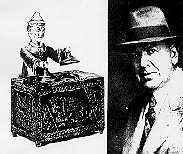CORONET - January, 1940
ANDREW EMERINE
WHO TAKES A POSTMAN'S HOLIDAY BY PUTTERING WITH TOY BANKS
 IN
THE days when thrift was held before the young as a primary and heaven-insuring virtue,
there was a quiet but fierce little competition among makers of toy banks. "Still
banks" did not, understandably, induce as much thrift as "mechanical banks"
(with moving parts, like "The Mikado," above) which grew amusingly ingenious in
design. Both types are now collectors' items and Andrew Emerine, bank president of
Fostoria, Ohio, has one of the finest groups extant. They fill a museum, number more than
1,700. Among them are most of the mechanicals, including such exclusives as "Red
Riding Hood" and "The Whale and the Sewing Machine." Emerine learned about
frugality when he earned money the hard way - harvesting. His busy home machine shop
manifests his interest in mechanics.
IN
THE days when thrift was held before the young as a primary and heaven-insuring virtue,
there was a quiet but fierce little competition among makers of toy banks. "Still
banks" did not, understandably, induce as much thrift as "mechanical banks"
(with moving parts, like "The Mikado," above) which grew amusingly ingenious in
design. Both types are now collectors' items and Andrew Emerine, bank president of
Fostoria, Ohio, has one of the finest groups extant. They fill a museum, number more than
1,700. Among them are most of the mechanicals, including such exclusives as "Red
Riding Hood" and "The Whale and the Sewing Machine." Emerine learned about
frugality when he earned money the hard way - harvesting. His busy home machine shop
manifests his interest in mechanics.
AMERICAN ANTIQUES JOURNAL - October, 1946
BANK STOCK BULLISH
By ANDREW EMERINE
IT
IS indeed surprising to the more matured collector to realize the demand that
exists today and the prices offered for certain rare old mechanical banks.
There is a wide variation of prices, however, which is determined by the number
of examples still available of any given kind. It is possible that there were
two thousand Eagle banks made and put into circulation and perhaps there was a
like number of Tammanies. These with many others classified as common, sell at
prices from $8.00 to $20.00.
Naturally the survivors of the banks that were made in decidedly fewer numbers
are now rare and sell readily at prices far in excess of any reasonable
appraised value.
During the years 1882 to 1895 a brightly painted Breadwinner, Circus Bank, or a
Professor Pug Frog and fifty other equally desirable banks were each packed in a
neat wooden box with slide lid, with the name of the bank thereon and sold by
the general store at $1.25 to $2.50; in many instances the sale of this
merchandise was not brisk.
There is certainly a marked contrast with these former prices and those of
today; a good old bank that has been tossed about by the youngster for tears,
and finally stowed away in an attic or thrown on a junk pile finds ready sale at
$15.00 to $100.00 according to the bank and its condition. There are a few top
banks, such as the Freedman's Bank, Bread Winner, Girl Skipping Rope, Harlequin,
and a few others that have been known to sell at $150.00, and in several
instances in excess of this figure.
Ten years ago there were but eight outstanding collectors of banks; today there
must be two or three hundred with collections ranging from 95 percent complete
to a modest group of thirty or forty banks. It would seem that it is a
reasonable guess that 90 percent of the surviving banks are now in the hands of
the collectors, and the remaining 10 per cent will be slow in coming to the
surface.
(Web note: Illustrations from a photo copy of the article
were not suitable for reproduction. Fowler, Jonah Emerges, Freedman's, Carnival,
Merry Go Round, and Initiation 1st & 2nd Degree - no captions)
